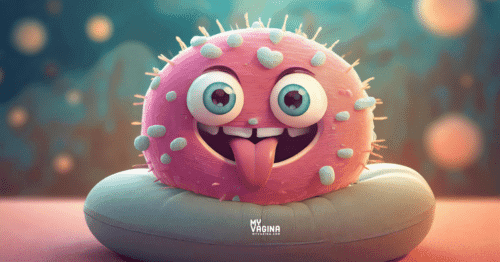Study: men carry BV-associated bacteria on and in their penises
Researchers tested the skin of the penis, urethra, head of the penis and urine and semen samples of the male partners of women with BV - men have it too!
Testimonials for Killing BV treatments
Wondering if My Vagina's Killing BV treatments work? Read real testimonials from real people who have had great success.
Secnidazole (Solosec) for BV
Secnidazole is an antibiotic used to treat bacterial and parasitic infections, including BV. It has about the same rate of cure as metronidazole.
Does your BV cause itching or soreness? Try BV Rescue
If your BV or AV causes itching or soreness, our new pessary product can take care of your vaginal irritation, as well as the BV or AV problem.
Iron deficiency and bacterial vaginosis, aerobic vaginitis
We examine the evidence as to whether low iron levels can contribute to bacterial vaginosis, aerobic vaginitis or other vulvovaginal dysbiosis/infection.
Got a new boyfriend and BV? How to explain it
We take you through a few tips on how to talk to a new guy about your vagina problems without destroying your self-esteem.
Having trouble convincing your guy that he’s part of the BV puzzle?
We help guide you through what to do with a man who is finding it difficult to accept his part in the BV problem, and is refusing to educate himself or treat himself.
Haemorrhoids and vaginal infections/UTIs
Haemorrhoids can cause faeces to accumulate around your anus after the toilet, creating a reservoir of bacteria. This bacteria can more easily spread to the vagina simply by regular movements. We offer some options for keeping your haemorrhoids debris-free.
Mobiluncus and bacterial vaginosis
Mobiluncus species are anaerobic bacteria found in the vagina and bowel, with two species identified that are connected with BV in women: Mobiluncus curtisii and Mobiluncus mulieris. Mobiluncus develops biofilms, is very mobile, and highly adhesive to vaginal epithelial cells.
Parvimonas micra in bacterial vaginosis
Parvimonas micra is usually found in the mouth and intestines, but can cause vaginal infections and be found in vaginal flora. P. micra is associated with BV and other vaginal infections.
Finegoldia magna in BV
Finegoldia magna is often found naturally in the vagina as a friendly commensal bacteria, but can also be associated with and contribute to bacterial vaginosis. Finegoldia magna can cause a vinegar or ammonia-like smell from the vagina, and compete with friendly lactobacilli.
Understanding vaginal pH
We explain vaginal pH and how it relates to your vaginal smells. If you have a funny smell coming out of your vagina and need to test your vaginal pH, we explain how.
What to do when your period smells like death
Got a vagina that smells like death? We explain what's going on in great detail, with treatment ideas, so that you can solve your bad vag problems quickly and effectively.
Microbes that gentian violet is effective (and ineffective) against
Look over the list of bacteria that gentian violet will be effective against to make sure your bacterial vaginosis bacteria is on the list. If it's not, you'll need to check the support section for the comparison chart of treatment options.
Killing BV Success Story: my BV is gone!
Another success story from the Killing BV treatment program, where both partners of the relationship are being treated using our one-of-a-kind methods.
Killing BV Success Story: I cured my BV!
A woman has cured her BV using a combination of the treatments we recommended to her, using our treatment program in Killing BV.
Strong ammonia smell in vagina – which bacteria you have in BV
We delve into what bacteria cause ammonia smells to come from your vagina, especially with a diagnosis of BV. There are only a few bacteria that cause ammonia-like vaginal odours, so you can narrow it down and get effective treatment.
What do BVAB1, BVAB2 and BVAB3 mean in BV tests?
We explain what they mean when they say 'BVAB' - bacterial vaginosis-related bacteria - in your BV test results, helping you to understand why these mysterious letters appear and what you can do about them.
BV – you also probably have it in your mouths
Discover how BV links to oral health issues. Learn about the research on BV's impact on the mouth and gums and get effective treatment.
Amsel’s criteria – BV diagnostics
Amsel's criteria is a group of diagnostic techniques to establish a diagnosis of bacterial vaginosis (BV). Amsel's criteria involves inspection of discharge, the whiff test, a pH measure, and the presence of clue cells (biofilm).






